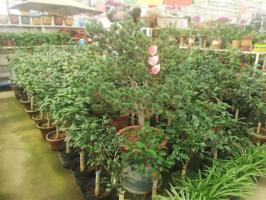How to Care for Hydrangeas in a Potted Plant
Hydrangeas are beautiful and delicate flowers that can be grown in a potted plant, making them an excellent addition to your indoor or outdoor decor. However, to keep your hydrangeas healthy and blooming, you must provide them with proper care. Below are some essential tips to help you care for your hydrangeas in a potted plant.
Choosing the Right Pot and Soil
The first step in caring for your hydrangeas is to choose the right pot and soil. Choose a pot that is large enough to accommodate the plant's roots but not too large that it holds too much water. A pot with drainage holes is essential to allow excess water to drain out.
For the soil, use a well-draining potting mix that is rich in organic matter. You can also mix perlite, sand, or vermiculite to enhance drainage. Avoid using heavy garden soil or compost, as they can retain too much water and suffocate the plant's roots.
Watering and Fertilization
Watering and fertilization are essential factors in hydrangea care. Hydrangeas need regular watering to keep the soil moist but not waterlogged. Make sure the soil is moist to a depth of 1-2 inches before watering again. Overwatering can lead to root rot and other diseases.
You can fertilize your hydrangeas once a month during the growing season with a balanced, water-soluble fertilizer. Avoid fertilizing in the winter months, as the plant is dormant and does not need nutrients.
Temperature and Sunlight
Hydrangeas thrive in moderate temperatures and bright, filtered light. They prefer temperatures between 60-70°F during the day and 50-60°F at night. Avoid exposing your hydrangeas to direct sunlight, as it can scorch their leaves and flowers.
In the summer months, you can move your potted hydrangeas outdoors to a shaded area. However, make sure to acclimate them slowly to avoid shock. Bring them indoors when the temperature drops below 50°F.
Pruning and Maintenance
Pruning is an essential part of hydrangea maintenance. You can prune your hydrangeas in the early spring to control their size and shape. Cut back any weak or damaged stems, and remove any dead or wilted flowers. Avoid pruning after midsummer, as this can remove next year's blooms.
Regularly inspect your hydrangeas for signs of pests, diseases, or nutrient deficiencies. Common pests include aphids, spider mites, and whiteflies. You can treat these pests with insecticidal soap or neem oil. Powdery mildew, root rot, and bacterial wilt are common diseases that can infect hydrangeas. Ensure proper drainage and avoid overwatering to prevent these diseases.
By following the tips above, you can ensure your potted hydrangeas thrive and produce stunning blooms year after year.

 how many times do yo...
how many times do yo... how many planted tre...
how many planted tre... how many pine trees ...
how many pine trees ... how many pecan trees...
how many pecan trees... how many plants comp...
how many plants comp... how many plants can ...
how many plants can ... how many plants and ...
how many plants and ... how many pepper plan...
how many pepper plan...
































